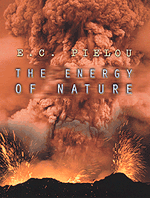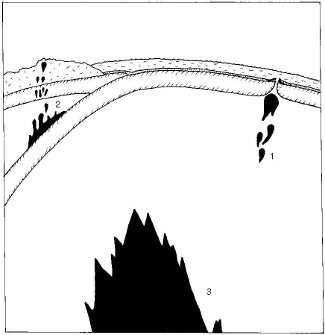How volcanoes work

While volcanic eruptions—like this recent one in the Alaskan wilderness—actually happen with some frequency, most do not make international headlines. The exception, of course, has been the recent eruption on Iceland’s Eyjafjallajökull glacier, which, due to the engine-choking plumes of ash it has spread throughout the jet stream, has severely disrupted air traffic all over Europe. So if you’re one of the many people stuck sitting around airports or hotel rooms with nothing better to do than wait out the “storm,” (or even if you’re not), why not bone up on your knowledge of such natural phenomenon with E. C. Pielou’s The Energy of Nature?
Pielou’s book is a fascinating exploration of energy’s role in nature—how and where it originates, what it does, and what becomes of it—and volcanoes of course, play a major role. The following is an excerpt from Chapter Fourteen:
…Consider volcanoes. Obviously the earth loses heat when volumes of red-hot lava gush out through the crust and cool off in the open air. Not so obvious is the reason the lava became molten in the first place. Volcanic lava (known as magma before it emerges into the open) usually comes from no great depth: it is molten mantle rock. It does not come from the core; although the outer core is liquid iron capable of flowing, it is far too dense to rise to the earth’s surface. The problem becomes, Why should mantle rock melt?
Most volcanoes are near the boundaries of tectonic plates. Mantle rock melts, and the magma collects to fill magma chambers, in two very different environments: where two plates separate, and where two plates meet with one
subducting below the other.
The rock melts in these two environments for two quite different reasons. Figure 15.2 shows what happens (note the sites labeled 1 and 2).
 |
| Figure 15.2. Ascending magma chambers full of magma (black) in the section shown in figure 15.1. Different kinds of magma chamber, labeled 1, 2, and 3, are formed by (1) the melting of ascending currents of mantle material; (2) frictional melting on the upper surface of a subducting slab; (3) the heat of a hot spot at the core-mantle boundary (far below the border of the figure). |
Where plates separate, a current of ductile mantle rock ascends from below; as the rock creeps up, the pressure weighing it down decreases until the combination of pressure and temperature is such that the rock liquefies; this is the process feeding volcanoes on midocean ridges.
Where two plates meet, the subducting slab sinks down into the mantle on which it had been floating. Frictional drag between the cool, dense slab and the warmer upper mantle rock through which it sinks generates sufficient heat to melt the overlying warm rock but not the cool, sinking slab.16 The reason the upper rock melts and the lower rock doesn’t is that the rock above contains considerable moisture, absorbed from wet ocean sediment, and wet rock melts at a lower temperature than dry rock does.
Unlike most volcanoes, which are found at plate boundaries, some erupt nowhere near the boundaries. These are hot-spot volcanoes, fed by plumes of hot rock rising from much greater depths (site 3 in fig. 15.2). The plumes
originate at localized hot spots at the bottom of the mantle where it is heated to tremendously high temperatures by currents in the liquid outer core. The temperature difference between a plume and the rock around it may be as
great as 1,500°C.
A hot-spot volcano is unaffected by the drift of the tectonic plates across the earth’s surface nearly 3,000 km above the hot spot itself. In this respect hot-spot volcanoes behave quite differently than plate-boundary volcanoes
do. The latter erupt wherever a boundary happens to be, because the magma sources travel with the plates; a hot-spot volcano, in contrast, is left behind by the plate moving over it; each time it erupts it punches a new hole through the ever-drifting crust and builds a new volcano some distance behind the site of the preceding eruption. As a result, the successive eruptions from a hot-spot plume create a row of volcanoes. The youngest volcano of the row is at the back of the line, with progressively older volcanoes ahead of it.
Rows of hot-spot volcanoes are seldom straight lines; more often they are gently curved arcs. Sometimes the arcs trail across a continent, sometimes across an ocean. If the summits of an arc of submarine hot-spot volcanoes are
high enough to emerge above sea level, the result is a volcanic island chain.
Several of them occur in the Pacific—for example, the Hawaiian Islands, the Aleutian Islands, the Kuril Islands, and the Tuamoto Archipelago. Note that each of the three kinds of volcano we’ve considered receives its
lava (or magma, while it’s underground) from a different source. Midoceanridge volcanoes get it from rising currents in the mantle, which melt when the pressure is low enough; the volcanoes above subducting slabs get it from moist, upper mantle rock that has been heated to its comparatively low melting point by friction; and hot-spot volcanoes get it from hot plumes rising from the bottom of the mantle. Note particularly that in no case does the melting require “new” thermal energy or energy from an outside source. The energy that volcanoes let loose has been inside the earth all along, waiting to be dissipated. There is plenty more down there still.
Generalizations about the energy released in volcanic eruptions would be meaningless because they are so variable. But it can safely be said that some past eruptions were larger by far than any experienced by human beings since our species evolved 3 or 4 million years ago. Eruptions two or three thousand times as powerful as the Mount St. Helens eruption of 1980 have left their mark on the earth.
On several occasions in the past, a newly developed hot spot has sometimes fed a long sequence of eruptions lasting for a few million years and leaving behind overlapping layers of volcanic rock (basalt) that now cover whole landscapes to considerable depths. Each eruption obliterated every living thing in its path. Examples of the present-day remains of such events are the sheets of lava forming the Columbia Plateau of Washington and Oregon, which flowed out of the ground in a series of eruptions about 17 million years ago and buried more than 100,000 km2 of land. A similar series of eruptions 65 million years ago produced the enormous terraced sheets of lava known as the Deccan that occupy most of peninsular India; their area is more than 500,000 km2.
These sequences of tremendous lava floods have happened at long intervals, on the order of tens of millions of years. Another such sequence could begin anywhere at any time. The earth still has plenty of energy to dissipate.